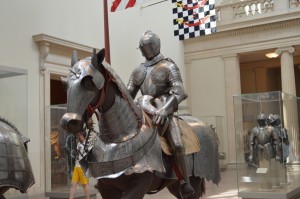A Knight’s Armor
 I’ve always found it fascinating the order in which a knight put on his armor. Seriously, think about it. He couldn’t just put the metal against his skin. Imagine the chafing!
I’ve always found it fascinating the order in which a knight put on his armor. Seriously, think about it. He couldn’t just put the metal against his skin. Imagine the chafing!
All in all, it would take a knight and his squire about fifteen minutes to put on full plate armor. This is based on reenactments. How did they don this impressive suit of armor?
First, the knight wore a linen undershirt and woolen stockings over his legs. Next, a knight donned a padded garment that was called many things – Gambeson or Doublet to name a few. This was sewn or padded with linen or even grass.
First, the Sabatons were put on. These were armor for the feet. Greveas was armor for the calf and ankles and was put on next. Poleyns was armor that protected the knee cap, followed by Cuisses which was thigh armor. So now, you have a knight in plate armor covering both legs. He was still mobile and could still drink or eat.
Some knights wore a chainmail tunic beneath their plate armor for added protection.
The breast plate and back plate would be put on next, followed by armor for the arms and hands. The Besagues were small rounded pieces of metal that protected the armpit. The Rerebrace was armor for the upper arm. The Vambrace was armor worn on the lower arm. And finally the Gauntlets, which were gloves and protected the hands, were put on.
Next would be protection for the neck and head. In the 13th century, the helmet had a skirt to protect the neck called the aventail.
Now, your knight was fully covered, from head to toe, in plate armor. But he was not ready for battle yet. A dagger and sword were attached to the knight’s belt. He carried a shield for protection and for recognition. His heraldry would be emblazoned on the front so that others could recognize him.
Now, he was ready to face any foe that came against him.

